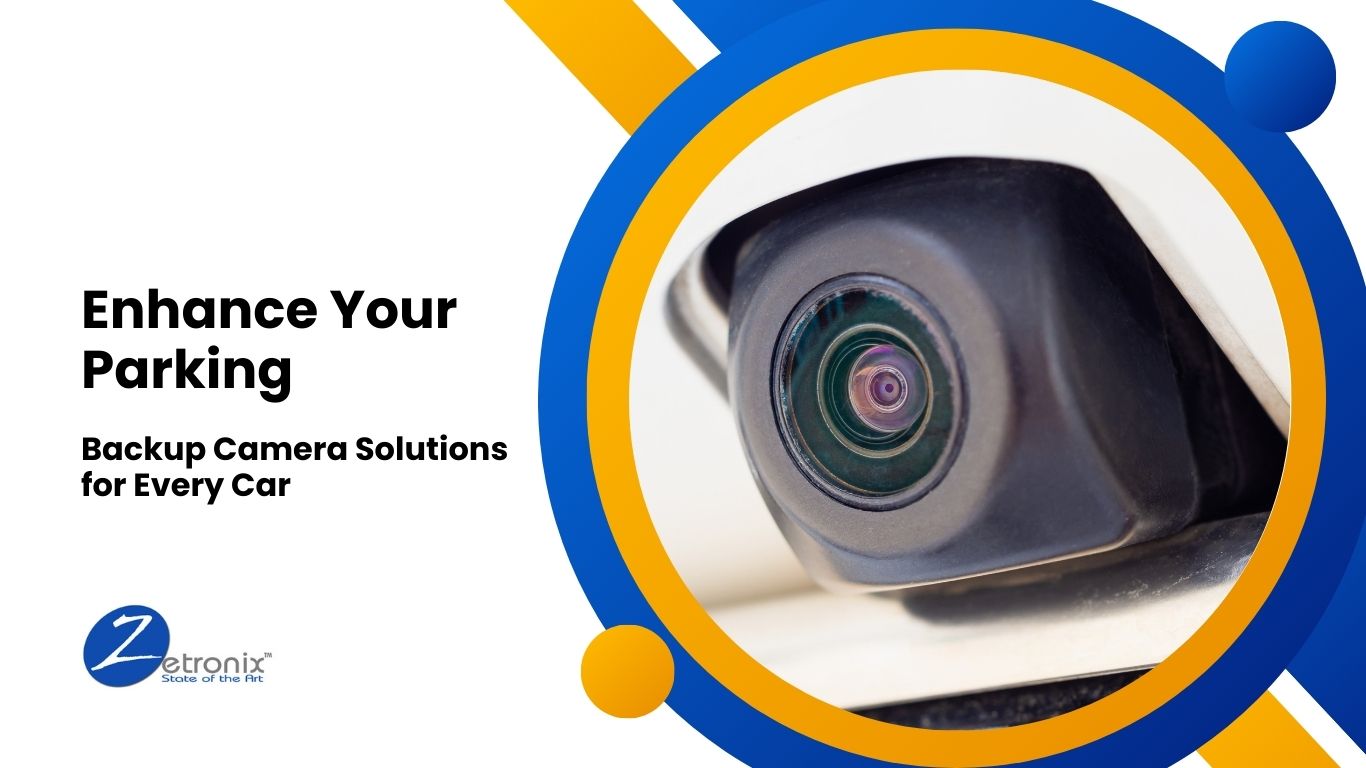Revolutionize Your Parking: Top Backup Camera Installations for Every Vehicle

In today’s fast-paced world, where every second counts, ensuring safety while driving is paramount. Parking mishaps, such as minor bumps and scratches, can be frustrating and costly. Fortunately, advancements in automotive technology have provided a solution: backup cameras. These nifty devices offer drivers a clear view of what's behind them, significantly reducing the risk of parking or reversing accidents. If you're considering upgrading your vehicle dash camera or a vehicle backup camera, you've come to the right place. In this comprehensive guide, we'll explore everything you need about backup camera installation, from the benefits to the top installations available for various vehicles.
Benefits of Backup Camera Installation

Before delving into the installation process, let's first understand why backup cameras are a worthy investment for your vehicle:
- Enhanced Safety: Backup cameras provide drivers with a clear view of the area behind their vehicle, helping to avoid collisions with obstacles, pedestrians, or other vehicles.
- Improved Visibility: Whether navigating through a crowded parking lot or reversing out of a tight spot, backup cameras offer enhanced visibility, especially in low-light conditions.
- Ease of Parking: Parallel parking and manoeuvring in confined spaces become less daunting tasks with the assistance of a backup camera, allowing for more precise and stress-free parking.
- Prevent Property Damage: By eliminating blind spots, backup cameras help prevent accidental damage to your vehicle and surrounding property, saving you from costly repairs.
How to Install a Backup Camera
While installing a backup camera might seem daunting, it's a relatively straightforward process. As I have very easy way to tell the backup camera installations near me. Here's a step-by-step guide:
- Gather Your Tools: Before you begin, ensure you have the necessary tools on hand, including a drill, screwdriver, electrical tape, and wire strippers.
- Choose the Camera Placement: Select an optimal location for mounting the camera on the rear of your vehicle, preferably centred and at a height that provides a clear view of the area behind.
- Mount the Camera: Using the appropriate mounting hardware, securely attach the camera to the chosen location, ensuring it is level and angled correctly.
- Run the Wiring: Carefully route the camera's wiring from the vehicle's rear to the front, avoiding any areas prone to damage or interference.
- Connect to Power: Identify a power source for the camera, such as the vehicle's reverse lights or an auxiliary power outlet, and connect the wiring accordingly.
- Connect to Display Unit: If your vehicle doesn't already have a built-in display for the backup camera, you'll need to install one. This typically involves mounting the display on the dashboard and connecting it to the camera's feed.
- Test the System: Once everything is connected, test the backup camera to ensure it's functioning correctly. Adjust the camera angle if necessary for optimal visibility.
- Secure and Seal: Once satisfied with the installation, secure any loose wiring and seal any openings to prevent water or debris from damaging the camera.
- Final Checks: Before hitting the road, double-check that the backup camera works as intended and that all components are securely installed.
Top Backup Camera Installations for Every Vehicle

Now that you're familiar with the installation process let's explore some of the top backup camera options available for different types of vehicles:
- Universal Backup Camera Kits: These kits are designed to be compatible with a wide range of vehicles and come with everything you need for a hassle-free installation. They typically include a camera, wiring harness, and display unit.
- OEM Integration Kits: For a seamless look and integration with your vehicle's existing features, consider an OEM (Original Equipment Manufacturer) backup camera kit. These kits are designed to work with your vehicle's factory-installed display unit, providing a factory-finished appearance.
- Wireless Backup Camera Systems: If you prefer a simpler installation without running wiring through your vehicle, wireless backup camera systems are an excellent choice. These systems transmit video wirelessly from the camera to a display unit, reducing installation time and complexity.
- Vehicle-Specific Kits: Some vehicles may have unique requirements or limitations regarding backup camera installation. Vehicle-specific kits are tailored to fit these vehicles perfectly, ensuring a seamless integration with minimal modification.
- Dash Cam with Backup Camera Functionality: Consider investing in a dash cam with built-in backup camera functionality for added versatility. These devices record your journeys and provide a clear view of the rear when reversing, offering both safety and security benefits.
Conclusion
Install backup camera, as it is a simple yet effective way to enhance the safety and convenience of your vehicle. Whether you opt for a universal kit, OEM integration, or wireless system, a backup camera solution suits every need and budget. By following the steps outlined in this guide and selecting the right installation option for your vehicle, you can revolutionize your parking experience and drive confidently, knowing you have an extra set of eyes at the back of your car. Don't wait until it's too late—invest in a backup camera today and enjoy stress-free parking for years.
Don't hesitate to reach out if you have any questions about backup camera installation or need assistance finding the perfect solution for your vehicle. Remember, safety always comes first, and a backup camera is valuable in ensuring you and your loved ones stay safe on the road.
FAQs
Q: How much does it cost to install a backup camera?
The cost of installing a backup camera can vary depending on factors such as the type of camera system, the complexity of installation, and whether you choose to do it yourself or hire a professional. Basic universal kits can start around $50-$100, while more advanced OEM integration or wireless systems may range from $150-$500 or more, including installation fees if you hire a professional.
Q: Can I install a backup camera, or do I need a professional?
While some DIY enthusiasts may feel comfortable installing a backup camera, others may prefer to leave it to the professionals, especially if it involves complex wiring or integration with existing vehicle systems. If you're unsure about your DIY skills or want to ensure a seamless installation, hiring a professional installer is wise.
Q: Will installing a backup camera void my vehicle's warranty?
In most cases, installing a backup camera should not void your vehicle's warranty, especially if it's a standalone aftermarket accessory that doesn't interfere with the vehicle's existing systems. However, it's always a good idea to check your vehicle's warranty terms and consult your dealership or manufacturer if you have any concerns.
Q: Do backup cameras work in all weather conditions?
Backup cameras are designed to work in various weather conditions, including rain, snow, and fog. However, extreme weather conditions or heavy precipitation may temporarily affect the camera's visibility. Regular maintenance, such as cleaning the camera lens and ensuring proper sealing, can help maintain optimal performance in all weather conditions.
Q: Can I use a backup camera as a primary rearview camera?
While backup cameras are primarily intended to aid in parking and reversing manoeuvres, they can also serve as a secondary or auxiliary rearview camera. However, for primary rearview visibility while driving, especially at higher speeds, it's recommended to use a dedicated rearview mirror or display.
Q: Are backup cameras legal and required on all vehicles?
Backup cameras are not yet mandatory on all vehicles, but they are increasingly becoming standard features due to safety regulations and consumer demand. Many newer vehicles come equipped with backup cameras as standard or optional equipment. However, regulations regarding backup camera requirements may vary by region, so it's essential to familiarize yourself with local laws and regulations.
Q: Can I install a backup camera on a vehicle with a spare tire mounted on the rear?
Yes, it's possible. However, consider the placement of the camera to ensure it provides an unobstructed view of the area behind the vehicle. Mounting the camera above or below the spare tyre or relocating the spare tyre to a different location may be necessary to achieve optimal visibility.
Q: Are there any wireless backup camera systems that don't require drilling or wiring?
Yes, wireless backup camera systems are available that don't require drilling or extensive wiring. These systems typically consist of a wireless camera and a display unit that communicate wirelessly, eliminating the need for running cables through the vehicle. However, minimal wiring may still be required for the power supply and connecting the display unit to a power source.
Q: Can I install a backup camera with a trunk-mounted license plate on a vehicle?
Back-up cameras can be installed on vehicles with trunk-mounted license plates. In such cases, the camera is typically mounted above or below the license plate to provide a clear view of the area behind the vehicle. Depending on the vehicle's design, you may need to modify the license plate mount or surrounding trim to accommodate the camera installation.
Q: Do backup cameras come with guidelines to assist with parking?
Many backup camera systems come equipped with guidelines, or gridlines overlaid on the camera's display to assist with parking and manoeuvring. These guidelines can help drivers gauge distance and trajectory when reversing and parking. Some systems even offer dynamic guidelines that move with the steering wheel to provide more accurate guidance.
Q: Can I install a backup camera on a vintage or classic car?
Back-up cameras can be installed on vintage or classic cars to enhance safety and convenience. However, installation may require additional considerations, such as finding compatible mounting locations and integrating the camera with the vehicle's electrical system. Custom installation may be necessary to achieve a seamless and aesthetically pleasing result while preserving the car's original appearance.
Q: Are there backup camera systems integrating with mobile devices or smartphones?
Yes, backup camera systems are available that integrate with mobile devices or smartphones, allowing you to view the camera feed directly on your phone or tablet. These systems typically utilize Wi-Fi or Bluetooth to transmit the camera feed to the mobile device, providing added flexibility and convenience.
Please let me know if you have any more questions or need further clarification about backup camera installation and functionality!




